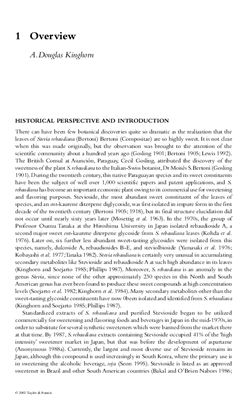2002 Taylor & Francis. Книга посвящена сравнительному обзору по
Стевии.
Historical perspective and introduction
comparison of stevioside to other natural product ‘High-Intensity’ Sweetening agents.
Physical properties, Solubility, And stability of
stevioside.
Analytical methods for the sweet stevia rebaudiana
glycosides.
Biosynthesis of stevioside and steviol.
Cultivation and cell culture of stevia rebaudiana.
Stevia rebaudiana is a remarkable South American plant which has become widely used in certain parts of the world as a natural sweetening agent and dietary supplement. Purified extracts of S. rebaudiana have been used as sweeteners and flavor enhancers in the food industry in Japan for over a quarter of a century, and have been found to be up to 300 times sweeter than sucrose.
This comprehensive volume provides reviews on the botany, ethnobotany, and chemical constituents of the genus Stevia and examines the chemical synthesis of such compounds as steviol and stevioside. The perceived safety of these compounds has become somewhat controversial in recent years, and a thorough consideration of the pharmacology and biological activity is provided. The final two chapters offer some insight into the various applications of S. rebaudiana extracts and stevioside in Japan and Korea, the two countries with the most extensive use of these food additives at present.
Containg numerous up to date references, the book will appeal to a wide segment of the scientific community at all levels, especially those in the fields of natural products, pharmacy, pharmacognosy, plant science, agriculture and the food and beverages industry
Historical perspective and introduction
comparison of stevioside to other natural product ‘High-Intensity’ Sweetening agents.
Physical properties, Solubility, And stability of
stevioside.
Analytical methods for the sweet stevia rebaudiana
glycosides.
Biosynthesis of stevioside and steviol.
Cultivation and cell culture of stevia rebaudiana.
Stevia rebaudiana is a remarkable South American plant which has become widely used in certain parts of the world as a natural sweetening agent and dietary supplement. Purified extracts of S. rebaudiana have been used as sweeteners and flavor enhancers in the food industry in Japan for over a quarter of a century, and have been found to be up to 300 times sweeter than sucrose.
This comprehensive volume provides reviews on the botany, ethnobotany, and chemical constituents of the genus Stevia and examines the chemical synthesis of such compounds as steviol and stevioside. The perceived safety of these compounds has become somewhat controversial in recent years, and a thorough consideration of the pharmacology and biological activity is provided. The final two chapters offer some insight into the various applications of S. rebaudiana extracts and stevioside in Japan and Korea, the two countries with the most extensive use of these food additives at present.
Containg numerous up to date references, the book will appeal to a wide segment of the scientific community at all levels, especially those in the fields of natural products, pharmacy, pharmacognosy, plant science, agriculture and the food and beverages industry

